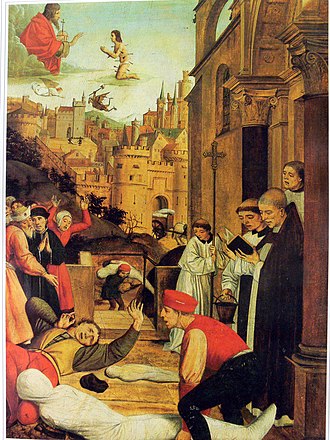Plague of Justinian
The Plague of Justinian was a major pandemic that afflicted the Byzantine Empire, including its capital, Constantinople, and parts of the Mediterranean world during the reign of Emperor Justinian I in the 6th century AD. This outbreak, caused by the bacterium Yersinia pestis, the same agent responsible for the bubonic plague, is considered one of the deadliest pandemics in history.

Origins and Spread[edit]
The plague is believed to have originated in China or Central Asia, eventually reaching the Byzantine Empire via infected rats that travelled on grain ships. The ships arrived in the port of Constantinople in 541 AD, triggering the outbreak.
Epidemiology and Impact[edit]
At its peak, the Plague of Justinian was killing an estimated 5,000 people in Constantinople every day and ultimately destroyed a significant portion of the human population in the eastern Mediterranean. It's estimated to have caused the deaths of 25 to 50 million people, about 25% of the world's population at the time.
The pandemic significantly impacted the Byzantine Empire, contributing to its decline. The loss of population caused labor shortages, economic decline, and political instability.
Symptoms[edit]
The symptoms of the Plague of Justinian were similar to those of later outbreaks of bubonic plague, and included fever, chills, headache, and swollen and painful lymph nodes. It's likely that, as with the later pandemics, the disease had bubonic, septicemic, and pneumonic forms.
Historical Significance[edit]
The Plague of Justinian had profound effects on the course of history, weakening the Byzantine Empire, altering the course of Christian and Islamic religions, and potentially accelerating the fall of the Roman Empire.
See Also[edit]
References[edit]
- Rosen, William (2007). Justinian's Flea: Plague, Empire, and the Birth of Europe. Viking Adult. ISBN 978-0-670-03855-8.
- Stathakopoulos, Dionysios (2004). "Crime and Punishment: The Plague in the Byzantine Empire, 541-749". In: Little, Lester K. (ed.). Plague and the End of Antiquity: The Pandemic of 541-750.
- Harper, Kyle (2019). The Fate of Rome: Climate, Disease, and the End of an Empire. Princeton University Press. ISBN 978-069119206-9.
External Links[edit]
Plague of Justinian - Ancient History Encyclopedia The First Pandemic: The Plague of Justinian - National Institutes of Health Plague of Justinian - Britannica
Ad. Transform your life with W8MD's Budget GLP-1 injections from $75


W8MD offers a medical weight loss program to lose weight in Philadelphia. Our physician-supervised medical weight loss provides:
- Weight loss injections in NYC (generic and brand names):
- Zepbound / Mounjaro, Wegovy / Ozempic, Saxenda
- Most insurances accepted or discounted self-pay rates. We will obtain insurance prior authorizations if needed.
- Generic GLP1 weight loss injections from $75 for the starting dose.
- Also offer prescription weight loss medications including Phentermine, Qsymia, Diethylpropion, Contrave etc.
NYC weight loss doctor appointmentsNYC weight loss doctor appointments
Start your NYC weight loss journey today at our NYC medical weight loss and Philadelphia medical weight loss clinics.
- Call 718-946-5500 to lose weight in NYC or for medical weight loss in Philadelphia 215-676-2334.
- Tags:NYC medical weight loss, Philadelphia lose weight Zepbound NYC, Budget GLP1 weight loss injections, Wegovy Philadelphia, Wegovy NYC, Philadelphia medical weight loss, Brookly weight loss and Wegovy NYC
|
WikiMD's Wellness Encyclopedia |
| Let Food Be Thy Medicine Medicine Thy Food - Hippocrates |
Medical Disclaimer: WikiMD is not a substitute for professional medical advice. The information on WikiMD is provided as an information resource only, may be incorrect, outdated or misleading, and is not to be used or relied on for any diagnostic or treatment purposes. Please consult your health care provider before making any healthcare decisions or for guidance about a specific medical condition. WikiMD expressly disclaims responsibility, and shall have no liability, for any damages, loss, injury, or liability whatsoever suffered as a result of your reliance on the information contained in this site. By visiting this site you agree to the foregoing terms and conditions, which may from time to time be changed or supplemented by WikiMD. If you do not agree to the foregoing terms and conditions, you should not enter or use this site. See full disclaimer.
Credits:Most images are courtesy of Wikimedia commons, and templates, categories Wikipedia, licensed under CC BY SA or similar.
Translate this page: - East Asian
中文,
日本,
한국어,
South Asian
हिन्दी,
தமிழ்,
తెలుగు,
Urdu,
ಕನ್ನಡ,
Southeast Asian
Indonesian,
Vietnamese,
Thai,
မြန်မာဘာသာ,
বাংলা
European
español,
Deutsch,
français,
Greek,
português do Brasil,
polski,
română,
русский,
Nederlands,
norsk,
svenska,
suomi,
Italian
Middle Eastern & African
عربى,
Turkish,
Persian,
Hebrew,
Afrikaans,
isiZulu,
Kiswahili,
Other
Bulgarian,
Hungarian,
Czech,
Swedish,
മലയാളം,
मराठी,
ਪੰਜਾਬੀ,
ગુજરાતી,
Portuguese,
Ukrainian


